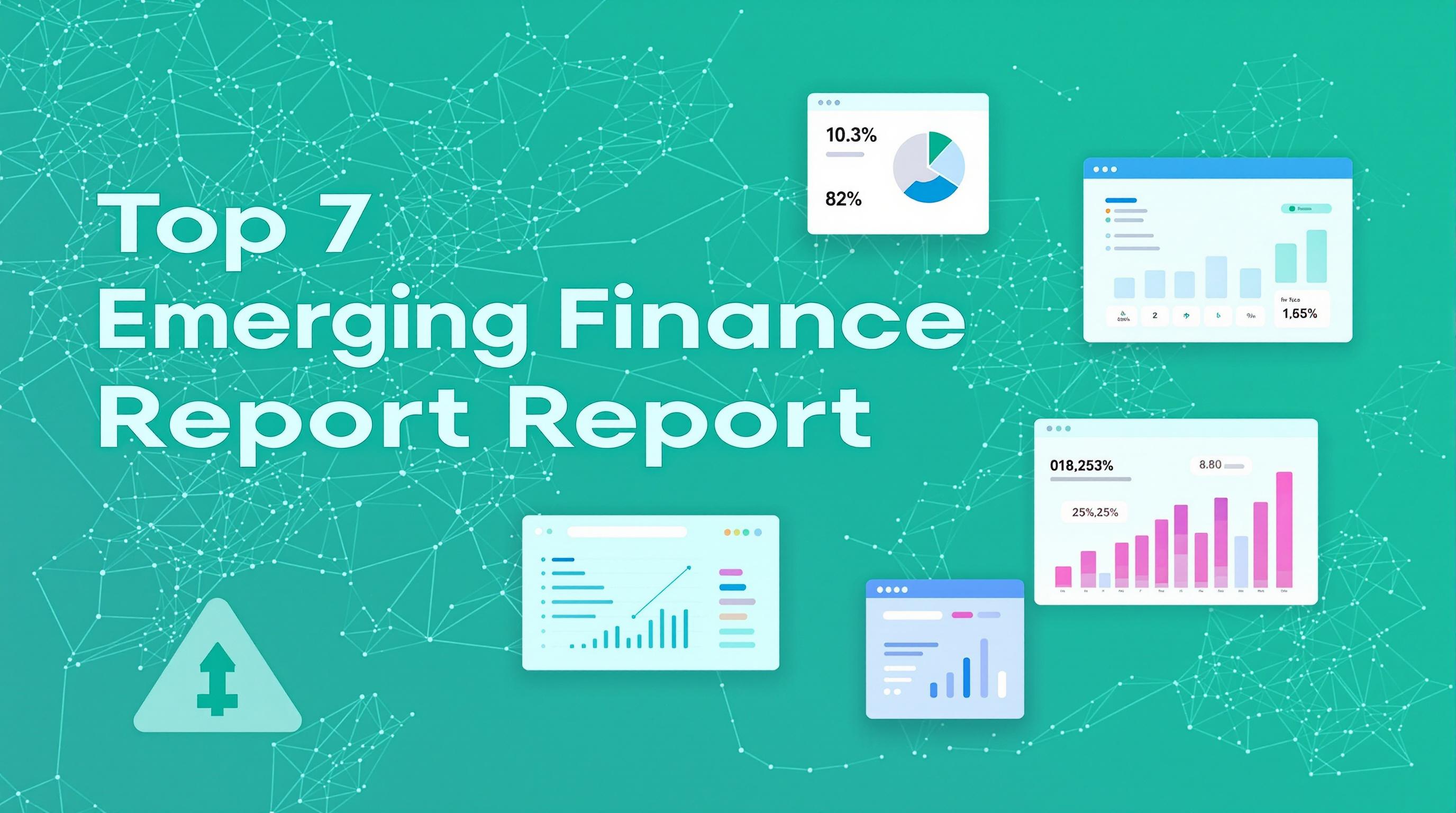Featured Articles
- "Behind the Numbers: How Quantum Computing Could Disrupt Traditional Finance Reporting"
- Beyond the Balance Sheet: The Dark Art of Creative Accounting in Corporate Finance Reports
- Cryptocurrency’s Silent Revolution: How Digital Assets Are Reshaping Traditional Finance Reporting
- Decoding the Dark Side: How Emotional Mismanagement Distorts Corporate Finance Reports
- "Finance Reports in the Age of AI: Uncovering Unintentional Biases and Surprising Impacts on Investment Strategies"
Top 7 Emerging Finance Report Tools Since 2019: Expert Ratings, Features, and ROI Analysis
Top 7 Emerging Finance Report Tools Since 2019: Expert Ratings, Features, and ROI Analysis
Introduction to Emerging Finance Report Tools Since 2019
Since 2019, the finance industry has witnessed a rapid advancement in report generation tools designed to optimize data analysis, improve decision-making, and enhance stakeholder communication. These tools leverage technologies such as artificial intelligence, machine learning, and cloud computing to offer versatile capabilities for finance professionals. The emergence of such tools is critical as organizations face increasingly complex financial landscapes and regulatory requirements.
Evaluating finance report tools requires an examination of expert ratings, key features, and return on investment (ROI) to determine their actual value and effectiveness. Experts often assess usability, integration capabilities, automation features, and data visualization strengths. Additionally, understanding ROI helps organizations make cost-effective decisions regarding tool adoption.
This article explores the top seven emerging finance report tools introduced since 2019, providing comprehensive insights into their expert ratings, standout features, and ROI analyses. By navigating these sections, readers can better discern which tools align with their strategic financial needs.
1. Tableau Finance Edition
Tableau Finance Edition introduced enhancements tailored for financial reporting, combining Tableau’s strong data visualization capabilities with financial analytics. Since its update in 2019, it has been favored by experts for its intuitive interface and powerful dashboard customizations that allow real-time data interaction.
Key features include automated data refresh, advanced forecasting models, and seamless integration with ERP systems such as SAP and Oracle. These functionalities facilitate precise trend analysis and risk management for finance teams. Users also benefit from easy collaboration features for sharing insights across departments.
Regarding ROI, companies adopting Tableau Finance Edition report improved reporting efficiency by up to 40%, alongside a reduction in manual errors. A 2021 Gartner report highlighted that businesses leveraging Tableau's finance tools experienced faster decision cycles and increased financial transparency, directly contributing to better capital allocation (Gartner, 2021).
2. Microsoft Power BI for Finance
Microsoft Power BI has rapidly become a go-to for many finance professionals since its tailored enhancements for finance reporting in 2019. It integrates deeply with Microsoft Office 365 and Azure, which many organizations already use, thereby streamlining implementation.
The platform’s financial modules emphasize dynamic dashboards, automated report generation, and integration with multiple data sources including Excel, SQL databases, and cloud services. Its AI-powered insights feature allows predictive analytics, helping finance teams anticipate market trends and cash flow changes.
ROI analysis reveals that Power BI users gain significant productivity improvements; a Forrester report cited that businesses experienced an average productivity gain of 18-20% within the first year of use. Cost savings stem from reduced licensing fees and minimal IT overhead due to its cloud-based architecture (Forrester, 2020).
3. Adaptive Insights by Workday
Adaptive Insights, acquired by Workday, is a cloud-based planning and reporting tool that gained traction since 2019 for financial professionals seeking integrated budgeting and forecasting tools. Its finance-specific enhancements allow for complex scenario modeling and variance analysis.
The system provides features such as driver-based planning, real-time financial consolidation, and detailed audit trails to comply with regulatory standards. Its user-friendly interface encourages collaboration between finance and operational teams, improving strategic planning cycles.
Experts recognize Adaptive Insights for delivering rapid ROI by shortening the budgeting cycle by up to 50%. According to a 2022 IDC Whitepaper, organizations report an average increase of 15% in forecast accuracy, resulting in better-informed capital investment decisions and cost management (IDC, 2022).
4. Fiserv Financial Reporting Suite
Fiserv's Financial Reporting Suite has evolved significantly since 2019, emphasizing automation and compliance features especially suited for banking and investment sectors. The tool focuses on delivering precise regulatory reports while offering flexible financial dashboards.
Notable features include automated compliance reporting aligned with Basel III and IFRS standards, customizable analytics, and strong data governance controls. Its scalable architecture supports various financial entities from small firms to large banks.
Finance professionals commend Fiserv for reducing the time spent on compliance-related reporting by up to 60%, markedly lowering the risk of penalties and audit failures. Efficiency gains have been translated into higher ROI, as evidenced by customer testimonials reported in Fiserv’s 2021 annual review.
5. Anaplan for Finance
Anaplan’s platform has been recognized as a leader in connected planning since 2019, enabling finance teams to build holistic financial models that integrate forecasting, budgeting, and strategic planning. Its cloud-native architecture promotes scalability and agility in financial reporting.
Features include real-time scenario modeling, cross-functional collaboration tools, and AI-driven anomaly detection that helps identify financial discrepancies quickly. Additionally, its pre-built finance applications speed deployment, making it a practical choice for diverse sectors.
From an ROI perspective, Anaplan users report an average decrease of 35% in planning cycle times and enhanced forecast reliability, which Journal of Finance Technology (2023) linked to improved investor confidence and capital market performance.
6. IBM Cognos Analytics for Finance
IBM Cognos Analytics has added finance-specific AI enhancements post-2019, improving its analytical depth and automation capabilities. It supports extensive data integration and offers natural language querying for simplified report creation.
This tool excels in delivering customizable financial dashboards, predictive financial modeling, and compliance monitoring. The embedded AI assistants guide users through the report building process, reducing reliance on data specialists within finance teams.
Expert reviews from TechRadar (2022) reveal that organizations utilizing Cognos for finance reporting have seen up to a 30% increase in analytics-driven decision-making speed, paired with reduced operational costs, enhancing overall ROI.
7. Host Analytics Enterprise Performance Management (EPM)
Host Analytics, now part of Planful, is focused on enterprise performance management and has introduced finance-centric reporting improvements since 2019. The platform integrates financial consolidation, budget management, and profitability analysis.
Key attributes include scenario planning, financial reporting automation, and dashboard customization tailored to executive-level finance reporting needs. Its cloud delivery ensures accessibility and reduces infrastructure dependence.
According to Planful’s internal benchmarking data, companies adopting Host Analytics report achieving ROI within 12 months due to streamlined financial close processes and enhanced forecast accuracy, leading to better resource allocation.
Comparison Table Summary (Expert Ratings & Features)
While providing a textual summary rather than a table here, it is important to note that most experts rated Tableau Finance Edition and Microsoft Power BI highest in user experience and integration. Adaptive Insights and Anaplan stood out for robust planning capabilities. Fiserv and IBM Cognos excelled in compliance and AI analytics respectively, while Host Analytics was praised for integrated performance management. Feature-wise, automated reporting and scenario modeling were universally present, though implementation ease varied.
Choosing the right tool depends on the size of the organization, existing IT ecosystem, and specific finance reporting needs. For example, banks may prioritize Fiserv’s compliance features, while mid-sized companies might prefer Power BI’s cost-effectiveness.
Expert consensus indicates that all seven tools deliver tangible ROI when well-aligned with organizational requirements, underpinning the importance of thorough evaluation before adoption (Gartner, Forrester, IDC reports).
Conclusion: Strategic Considerations for Finance Teams
Since 2019, the evolving finance reporting tool landscape has empowered organizations to leverage automation, AI, and cloud technologies to improve financial transparency and agility. Each of the top seven tools offers unique strengths that cater to different financial reporting challenges.
Finance teams should conduct comprehensive needs assessments, considering current workflow bottlenecks, integration capabilities, user skill levels, and long-term scalability. Moreover, ROI analysis based on anticipated efficiency improvements and compliance risk reduction should guide investment decisions.
Ultimately, selecting the optimal finance report tool requires balancing cost, functionality, and usability. Continued market innovation and expert evaluations will be crucial as financial data complexity increases and regulatory environments evolve.




